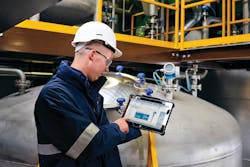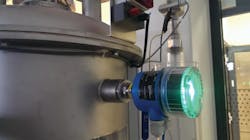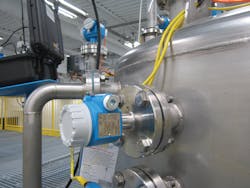Vibrating fork level instruments come of age
Vibrating fork level instruments — also called vibronic instruments — are widely used in the process industries. Available from multiple manufacturers, millions of these devices have been installed worldwide over the past few decades. One instrument manufacturer, Endress+Hauser, produces 330,000 Liquiphant level instruments (Figure 1) each year, and has sold six million units since 1983.
While the basic technology of vibronic instruments hasn’t changed much over the years, today’s instruments now employ technological innovations to bring them into the digital age, meet the needs of Industry 4.0 and the Industrial Internet of Things (IIoT), provide diagnostics themselves and provide access from mobile devices. This article describes those developments and shows how they benefit end users.
Inside vibronic instruments
Vibronic instruments consist of a transmitter and a sensor. The sensor portion of the instrument uses a tuning fork (Figure 2) that’s excited at its resonant frequency of about 85 Hz by a piezoelectric crystal, with a second crystal detecting the vibration produced by the first. The frequency decreases when the fork is covered by a liquid, and this change is analyzed and translated into an on/off output signal by the instrument’s transmitter.
Vibronic instruments are well-suited for liquid level applications, including point detection at the top and bottom of tanks, certified leakage monitoring and overfill prevention, use in hazardous environments and in applications requiring safety integrity level (SIL) two and three certification. These instruments can be used in storage tanks, containers and pipes for point level detection of all types of liquids.
In the oil and gas sector, refineries rely on vibronic instruments because they are among the most reliable of measuring instruments. This allows these devices to be used in critical applications such as overfill protection and pump dry run prevention.
Unlike float switches, vibronic instruments do not require maintenance and have a long service life. In addition, most are corrosion resistant.
Other advantages of vibronic instruments include:
Unaffected by media viscosity and density — Vibronic instruments can be used to measure the presence of liquids with viscosities up to 10,000 mm2/s and densities greater than 0.3 g/cm3.
Unaffected by media properties — A vibronic instrument is not affected by changing flow, turbulence, gas bubbles, foam, vibration, solids content or build-up.
Easy installation and ready for use without calibration — In most cases, a vibronic instrument works in the application without any required adjustments or calibration.
No wear and tear, maintenance-free — A vibronic instrument has no moving parts and requires no maintenance other than periodic cleaning.
Self-monitoring — New vibronic instruments are equipped with internal diagnostics and the ability to automatically perform proof tests and verification.
Checking for corrosion
Vibronic instruments have no moving parts, so the only physical problems they might encounter are corrosion and build-up of process materials on the tuning forks.
Most vibronic instruments are available with tuning forks made of corrosion-resistant metals, such as 316/316L stainless steel, Alloy C22 and PFA coatings, but aggressive chemicals can eventually eat through even these types of materials. When tuning forks corrode, they can break off, vibrate erratically or fail completely.
Build-up of process materials on the forks can also occur, especially in processes with entrained solids, turbulence or foam. A limited amount of coating changes the frequency of the probe but does not cause it to fail — i.e., a lightly coated instrument can still operate. But when build-up on the tuning forks becomes excessive, it can cause the device to fail and not detect changes in liquid level.
Modern vibronic instruments have built-in diagnostics to detect corrosion and build-up by monitoring the frequency of the tuning fork. Early detection allows plant personnel to address issues in a proactive manner prior to failure.
Proof testing
A proof test confirms the SIL rating of a safety instrumented function. NAMUR provides guidelines on what proof testing is needed to meet the requirements of IEC 61508-6, B3.2.5. NAMUR Worksheet NA-106 (Issue: 2018-09-06), Annex D, is typically referenced in the process industries — such as chemical, petrochemical and oil and gas — as well as in other process plants with hazardous operations.
Point level instruments in these and other similar applications may have to be periodically proof tested to meet various safety regulations. This can pose a problem with older instruments as they may have to be removed from the process for testing.
Fortunately, many new vibronic level instrument have the ability to perform a proof test on demand, which complies with IEC 61511 and ISA 84 safety standards. For example, a proof test for the Endress+Hauser Liquiphant FTL51B can be activated from a control room by sending a command over a wired connection, from a mobile device via wireless Bluetooth or directly at the device.
When activated, the Liquiphant transmitter tests the instrument's level notification and fault notification (alarm) functions. After interrupting power to the instrument supply, a test cycle is activated, which checks the instrument and electronics.
This test is approved for IEC 61508-6 and for overfill protection, according to the German Water Resources Act (WHG).
Validating verification
Process manufacturing and other industrial facilities must often provide documented evidence of level instrument performance to maintain compliance with various regulatory agencies. Typical requirements are:
Level instruments have to be verified at regular intervals
Verification has to be performed by a qualified third party and with an accepted inspection method based on quality regulations such as ISO 9001
A test report needs to be provided for documented proof of verification
The chemical and oil and gas industries have requirements for proof testing per IEC 61511, ISA 84 and other standards, while the oil and gas industry must adhere to contractual agreements between buyer and seller and comply with government agency mandates.
Most level instruments at the bottom or high point of a tank are frequently immersed in liquid and regularly activated. But, some high-high level instruments (Figure 3) are seldom or never immersed in liquid, so they require periodic verification.
Regulatory requirements are commonly fulfilled by removing the level instrument, taking it to a lab and immersing it in a liquid to verify operation (commonly called a “bucket test”). Damages during transport or handling can sometimes stay undetected and lead to a situation where a recently tested instrument is not performing per specifications. Performing verification in this manner is also costly and time-consuming, and it requires field work to remove and reinstall the instrument. Operator exposure to the chemical process is a safety concern.
To address these issues, many modern vibronic instruments can perform on-board verification in situ. The instrument’s transmitter electronics run an on-board diagnostics program, where all relevant components of the instrument are checked to confirm and document that it is still in calibration, with none of the components drifting outside of original tolerances.
For example, verification of an Endress+Hauser Liquiphant level instrument includes testing of all electrical connections and power versus factory specifications.
Endress+Hauser’s Heartbeat Technology fully complies with the requirements for traceable verification according to DIN EN ISO 9001:2008, Section 7.6 a, “Control of monitoring and measuring equipment.” Upon completion of verification, the technology generates a PDF report summarizing results, which can be used to satisfy audit requirements.
Meeting IIoT demands
The demands of Industry 4.0 and IIoT are limited for point level instruments. However, predictive maintenance and process optimization software programs need data relating to instrument performance.
Most instrument manufacturers have extensive software to acquire, store and analyze data from smart devices, such as vibronic point level instruments. These software packages — like Endress+Hauser’s Heartbeat Technology — are able to analyze data from proof tests and verifications.
Mobile computers and wireless technology make it possible for a technician on the plant floor to identify a device, commission it, check the status, perform a proof test or verification and download verification documentation. Then, if the situation warrants further attention, the technician can download the relevant manuals, certificates or other documentation related to the instrument.
These types of digital capabilities allow vibronic instruments to meet Industry 4.0 and IIoT requirements.
Summary
Point level instruments once led a simple life, only indicating if a liquid was present or not. Today, level instruments have to conform to various safety regulations, diagnose themselves, perform self-testing and provide data for IIoT and other digital initiatives. Modern vibronic instruments are up to the task, continuing to provide reliable operation for level detection, with added functionality to meet current and future demands.
Brent Frizzell is the Product Marketing Manager for Level at Endress+Hauser USA. His responsibilities include developing the strategy and marketing material for level, tank gauging, and terminal automation solutions for the US market. Brent has a bachelor’s degree in Chemical Engineering from Rose-Hulman Institute of Technology and graduated in 2012.



